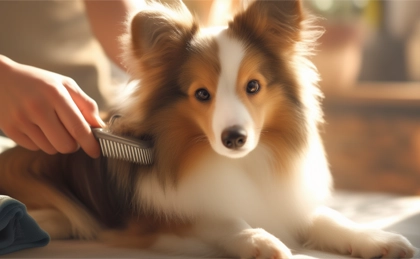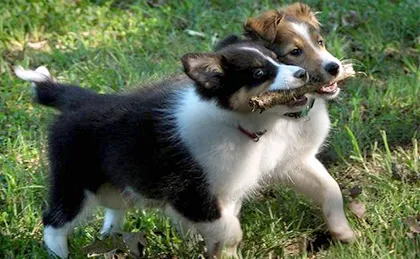Like people, individual dogs are intelligent in different ways. But generally speaking, a breed with an acute and well-honed ability to work will be quick to learn how to do its job and stick to it. Other breeds may be so attentive and trainable that they can carry out a range of tasks not prescribed by their breeding history, such as guide dogs for the blind.
However, natural intelligence alone doesn't make a good pet. We have to be willing to put in the work to channel our dog's smarts. Left untrained and without a job to do, an intelligent dog can become a neurotic mess. Always bear this in mind before you adopt a smart breed of dog. Here are the top ten most intelligent dog breeds in the world today.
1. The Border Collie
Border Collies are known for using their eyes when herding, controlling the sheep with an intense stare that shows they mean business. Border Collies are high energy dogs, having been bred to cover many miles a day in their native Scotland.

Britain's Border Collie is often considered the finest sheep herding dog in the world, bred for working ability over appearance.
Border Collies require and thrive on activity, so be prepared to keep them occupied. They are best suited to homes with yards and families that will take the time to train and work them. They excel in obedience, agility, flyball and, of course, herding. They're good with children and make excellent watchdogs.
2. The Poodle
The Standard Poodle is the original from which the Miniature and Toy breeds were developed. The coat has a dense, harsh texture and may be in any solid color: black, brown, gray, apricot, cream or white, with dark pigmentation of nose, lips and eye rims. To keep the coat mat-free, it should be brushed daily and clipped regularly, at least four times a year. Special care should be taken to keep the Poodle's long, thickly feathered ears clean and free from infection.
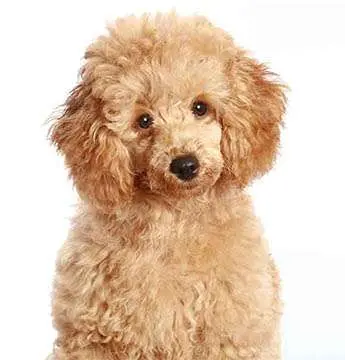
The Poodle's versatility makes it at home in any arena, from the show ring to the field.
With its well-mannered demeanor, clean habits, non-shedding coat and desire to please, the Poodle makes a superior house pet for town or country. The Standard needs plenty of outdoor exercise, is an excellent watchdog and loves playing with children.
3. The German Shepherd
The most popular breed for military and police service, they are also often chosen for search-and-rescue work, as well as a guide and hearing assistance dog. Bred specifically to work with humans, the breed is easy to train and will learn commands at record speed.
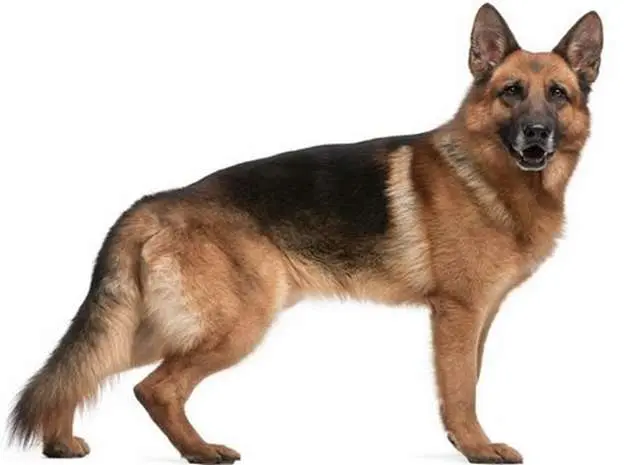
The German Shepherd Dog today is a true working dog: protective, loyal and highly intelligent.
Training should begin at an early age provided the more strenuous exercises are not overdone. If you don’t provide him with a job, a German Shepherd might find his own employment like patrolling for squirrel invasions. Given their size and high activity levels, German Shepherds are best suited to homes with yards. Lots of daily outdoor exercise is a must.
4. The Golden Retriever
Classic good looks and a sunny temperament make the Golden Retriever the quintessential dog for many pet owners. Easy to train with a biddable nature, Goldens are typically happy with just about any activity their owners choose – from agility and rally to therapy or obedience. The one exception may be watch or guard dog training; few Goldens can be convinced the world isn't all fun and games.

Golden Retrievers are used in many capacities including serving as guide dogs and therapy dogs.
Goldens enjoy interaction of almost any kind – from socializing at the local dog park to family walks or backyard romps. Although gentle and typically good with children, Goldens aren't meant to sit around; they thrive on exercise such as swimming or ball-chasing.
5. The Doberman Pinscher
Louis Doberman, a tax collector, wanted a strong and loyal breed to keep him safe on his rounds. He crossed several breeds, possibly including the German Pinscher, Rottweiler, Manchester Terrier and the Greyhound to create the Doberman we know today.
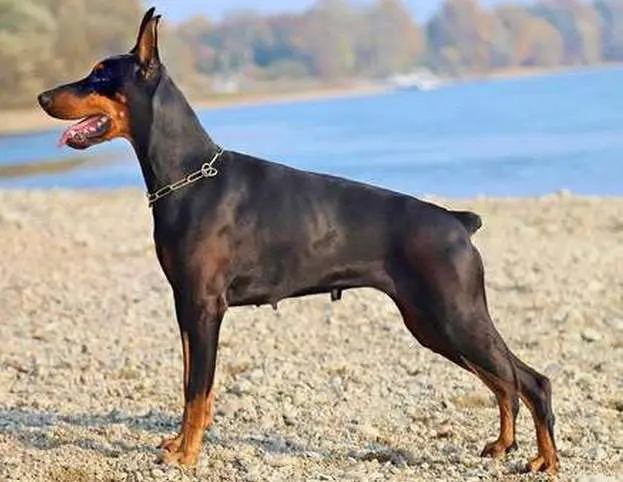
The Doberman Pinscher was first developed in Germany to facilitate tax collection!
Dobermans are bred to work. They're easily trained and excel in security, police and military work, as well as dog sports, obedience and of course, home protection. They need significant exercise, so be prepared for long walks if you live in an apartment. Dobermans may be strong, but they're often soft about their loved ones—children and animals included. Early socialization and long-term training allow the Doberman to develop his protective traits and learn to separate friend from foe in a reliable manner.
6. The Shetland Sheepdog
Thanks to its Collie ancestry, the Shetland Sheepdog makes a surprisingly intelligent small dog breed, which excels in agility and obedience and is easy to train with the correct dog training methods.
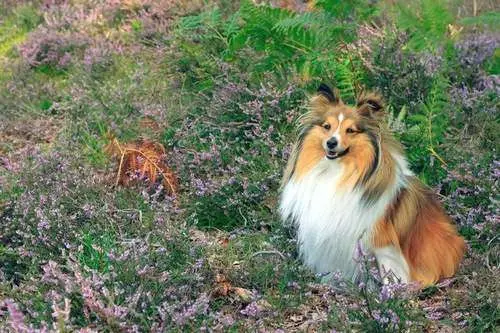
Shelties are the smartest of the small dog breeds.
Shetland Sheepdogs used to be called Toonies—a name taken from "tun", the Norwegian word for farm. It was a farm dog whose workplace was the unfriendly terrain of the Shetland Islands off the northeast coast of Scotland. To this day Shelties displays a strong sense of boundary, a legacy perhaps from these early working days when to overstep the line meant a fall from a rocky cliff into the cruel sea.
Shelties are a popular family pet suited to almost any size home. Its exercise needs are easily satisfied with a daily walk, while a thorough weekly brushing takes care of grooming needs. The Sheltie aims to please and excels in obedience work. Shelties can be barky, so apartment life may not be for them unless they have human company during the day. They are, however, excellent watchdogs and enjoy playing with children.
7. The Labrador Retriever
Descended from dogs found in Newfoundland by explorers, fishermen and settlers, the Labrador Retriever evolved by natural selection. Today it is consistently the most popular dog in the US, Canada and the UK. The coat is short, dense and hard in colors of black, yellow or chocolate. A good brushing three times a week will remove dead hair and keep the coat shiny.
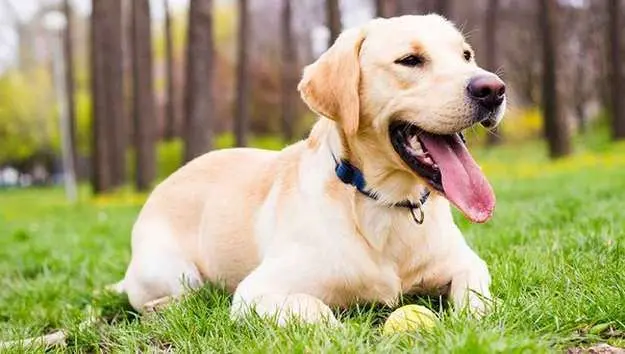
Lead a Labrador to a body of water and it will retrieve all day: balls, sticks and even children who might happen to go for a swim.
The Labrador is easy to train and excels as a field dog and in obedience trials. Labs enjoy outdoor exercise and are especially fond of swimming. This medium-sized, high-energy dog is best suited to a suburban or country home with a yard and a family that can provide it with the activity it loves.
8. The Papillon
The Papillon is an elegant, friendly toy dog measuring from 8-11 inches at the shoulder. Its long coat is fine and silky, adorned with a frill on the chest. The coat is usually white with patches of color from lemon to deep chestnut, but it can also be black and white with tan markings.
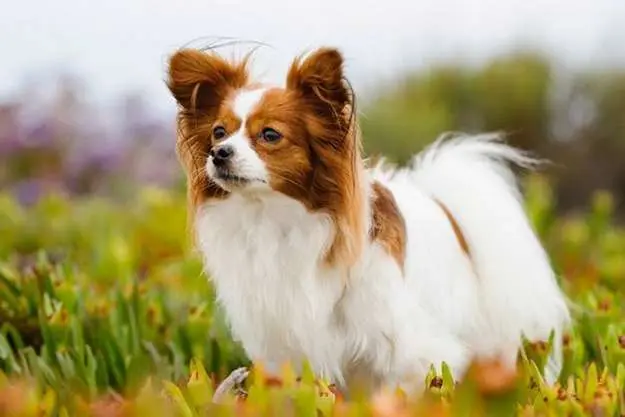
The name Papillon is French for butterfly and refers to the breed's erect, fringed, mobile ears.
The Papillon makes an excellent family pet for any size home and is ideally suited for stay-at-home types. Weekly brushing and the occasional bath are all the grooming required and two or three short walks or playtimes each day meet the little dog's exercise needs. Although small, the Papillon is fond of children and is a good playmate as long as things don't get rough. These dogs are smart and willing to learn just about anything, including pulling tiny carts. The breed tends to be protective and makes a great watchdog.
9. The Rottweiler
Rottweilers today thrive on working, protecting and keeping active. Extremely loyal, a Rottie must be socialized and trained early to keep his protective drive in check (keeping burglars out is great, but you may want him to let your new friends come in).

Dating back to the Roman Empire, early Rottweilers guarded and protected the cattle of armies.
Strong and athletic, a Rottweiler needs vigorous workouts, not a mere walk around the block. Along with exercise, a Rottie needs daily interaction with the family. A properly-trained Rottweiler will adore and protect his own children, but his sheer size may be an issue with very young children. While Rottweilers are typically good with animals in their family, they should be closely supervised with others. After all, a wary Rottie may resist following the "everyone's my new best friend" philosophy at his local dog park.
10. The Australian Cattle Dog
The dog is a sturdy, compact, symmetrically built, tough working dog with strength, stamina and endurance. They are natural guardians and eager companions for children. With their ardent desire to please and extreme intelligence, they do well in the obedience ring. They're also easy to show in the breed ring, with cleanliness and nail trimming the only grooming needed. Their short coats shed moderately, but a weekly brushing keeps hair to a minimum.

The Australian Cattle Dog was originally bred to heel cattle in Australia's rough outback.
Like most smart dogs that tend to think for themselves, Australian Cattle Dogs respond well to firm, consistent training. They are excellent watchdogs and enjoy playing with children. These high energy dogs need plenty of exercise several times a day.
It's great owning a smart dog—it makes dog training super easy and fun for both of you. However, intelligent dogs also needs lots of stimulation. They must not be left cooped up for hours or they will indulge in obsessive and even destructive behaviors. Border Collies are especially known for this as the #1 smartest dog breed in the world.
